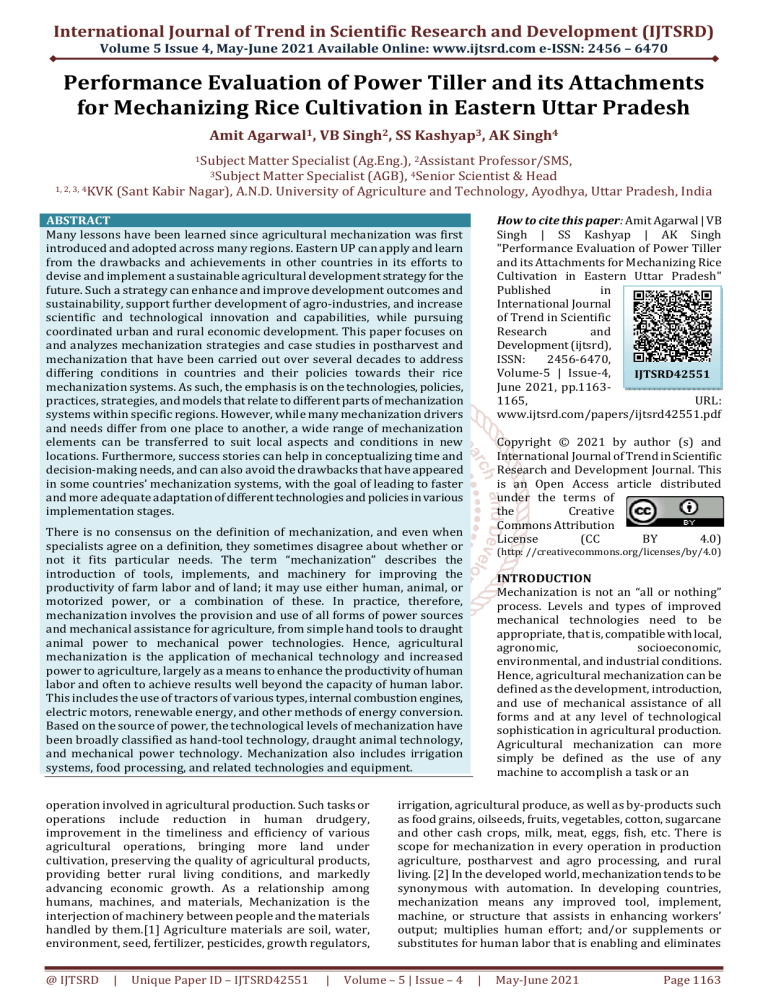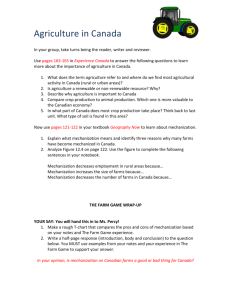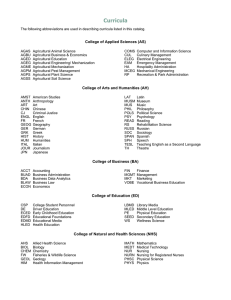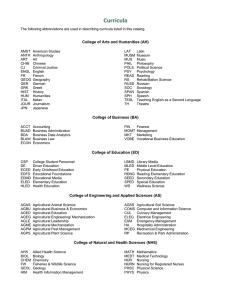
International Journal of Trend in Scientific Research and Development (IJTSRD)
Volume 5 Issue 4, May-June 2021 Available Online: www.ijtsrd.com e-ISSN: 2456 – 6470
Performance Evaluation of Power Tiller and its Attachments
for Mechanizing Rice Cultivation in Eastern Uttar Pradesh
Amit Agarwal1, VB Singh2, SS Kashyap3, AK Singh4
1Subject
Matter Specialist (Ag.Eng.), 2Assistant Professor/SMS,
Matter Specialist (AGB), 4Senior Scientist & Head
1, 2, 3, 4KVK (Sant Kabir Nagar), A.N.D. University of Agriculture and Technology, Ayodhya, Uttar Pradesh, India
3Subject
How to cite this paper: Amit Agarwal | VB
Singh | SS Kashyap | AK Singh
"Performance Evaluation of Power Tiller
and its Attachments for Mechanizing Rice
Cultivation in Eastern Uttar Pradesh"
Published
in
International Journal
of Trend in Scientific
Research
and
Development (ijtsrd),
ISSN:
2456-6470,
Volume-5 | Issue-4,
IJTSRD42551
June 2021, pp.11631165,
URL:
www.ijtsrd.com/papers/ijtsrd42551.pdf
ABSTRACT
Many lessons have been learned since agricultural mechanization was first
introduced and adopted across many regions. Eastern UP can apply and learn
from the drawbacks and achievements in other countries in its efforts to
devise and implement a sustainable agricultural development strategy for the
future. Such a strategy can enhance and improve development outcomes and
sustainability, support further development of agro-industries, and increase
scientific and technological innovation and capabilities, while pursuing
coordinated urban and rural economic development. This paper focuses on
and analyzes mechanization strategies and case studies in postharvest and
mechanization that have been carried out over several decades to address
differing conditions in countries and their policies towards their rice
mechanization systems. As such, the emphasis is on the technologies, policies,
practices, strategies, and models that relate to different parts of mechanization
systems within specific regions. However, while many mechanization drivers
and needs differ from one place to another, a wide range of mechanization
elements can be transferred to suit local aspects and conditions in new
locations. Furthermore, success stories can help in conceptualizing time and
decision-making needs, and can also avoid the drawbacks that have appeared
in some countries’ mechanization systems, with the goal of leading to faster
and more adequate adaptation of different technologies and policies in various
implementation stages.
Copyright © 2021 by author (s) and
International Journal of Trend in Scientific
Research and Development Journal. This
is an Open Access article distributed
under the terms of
the
Creative
Commons Attribution
License
(CC
BY
4.0)
There is no consensus on the definition of mechanization, and even when
specialists agree on a definition, they sometimes disagree about whether or
not it fits particular needs. The term “mechanization” describes the
introduction of tools, implements, and machinery for improving the
productivity of farm labor and of land; it may use either human, animal, or
motorized power, or a combination of these. In practice, therefore,
mechanization involves the provision and use of all forms of power sources
and mechanical assistance for agriculture, from simple hand tools to draught
animal power to mechanical power technologies. Hence, agricultural
mechanization is the application of mechanical technology and increased
power to agriculture, largely as a means to enhance the productivity of human
labor and often to achieve results well beyond the capacity of human labor.
This includes the use of tractors of various types, internal combustion engines,
electric motors, renewable energy, and other methods of energy conversion.
Based on the source of power, the technological levels of mechanization have
been broadly classified as hand-tool technology, draught animal technology,
and mechanical power technology. Mechanization also includes irrigation
systems, food processing, and related technologies and equipment.
operation involved in agricultural production. Such tasks or
operations include reduction in human drudgery,
improvement in the timeliness and efficiency of various
agricultural operations, bringing more land under
cultivation, preserving the quality of agricultural products,
providing better rural living conditions, and markedly
advancing economic growth. As a relationship among
humans, machines, and materials, Mechanization is the
interjection of machinery between people and the materials
handled by them.[1] Agriculture materials are soil, water,
environment, seed, fertilizer, pesticides, growth regulators,
@ IJTSRD
|
Unique Paper ID – IJTSRD42551
|
(http: //creativecommons.org/licenses/by/4.0)
INTRODUCTION
Mechanization is not an “all or nothing”
process. Levels and types of improved
mechanical technologies need to be
appropriate, that is, compatible with local,
agronomic,
socioeconomic,
environmental, and industrial conditions.
Hence, agricultural mechanization can be
defined as the development, introduction,
and use of mechanical assistance of all
forms and at any level of technological
sophistication in agricultural production.
Agricultural mechanization can more
simply be defined as the use of any
machine to accomplish a task or an
irrigation, agricultural produce, as well as by-products such
as food grains, oilseeds, fruits, vegetables, cotton, sugarcane
and other cash crops, milk, meat, eggs, fish, etc. There is
scope for mechanization in every operation in production
agriculture, postharvest and agro processing, and rural
living. [2] In the developed world, mechanization tends to be
synonymous with automation. In developing countries,
mechanization means any improved tool, implement,
machine, or structure that assists in enhancing workers’
output; multiplies human effort; and/or supplements or
substitutes for human labor that is enabling and eliminates
Volume – 5 | Issue – 4
|
May-June 2021
Page 1163
International Journal of Trend in Scientific Research and Development (IJTSRD) @ www.ijtsrd.com eISSN: 2456-6470
drudgery or stresses that adversely affect human health and
mental faculties, leading to errors, imprecision, hazards, and
loss of efficiency.[3]
The general pattern for the adoption and growth of
mechanization is found to be similar in most countries
worldwide. Historically, it usually started with farm
operations requiring high power inputs and low levels of
control (e.g., tillage, transport, water pumping, milling,
threshing). From there, farm operations requiring medium
levels of power and control were mechanized (e.g., seeding,
spraying, intercultural operations). Farm operations in
eastern UP requiring a high degree of control and low power
inputs were usually mechanized last (e.g., transplanting).
That is because any power-intensive work can be replaced
relatively easy using readily available mechanical means like
internal combustion engines and at a reasonably low cost,
whereas converting human knowledge into machine
capacity is often more difficult and costly.[4]
Some specific constraints are poor quality of equipment; lack
of common components and standard designs of equipment;
acute shortage of equipment testing facilities; and lack of
education, training, and popularization of farm equipment
among end-users. This is often caused by inadequate
training facilities for farmer-users, tradesmen, and artisans;
inadequate service centers; and lack of regulations on
custom hiring services, e.g., custom farm work agreement,
workplace safety, environment matters.[5]
DISCUSSION
Mechanization is also driven by various other factors
including socioeconomic conditions, farming systems,
population density, government policy, rural labor wages,
and farmer support for agricultural mechanization .These
are some of the factors that explain why some countries
mechanize faster than others. In short, the introduction of
agricultural technology, including mechanization, consists of
complex processes and drivers. The formulation of an
agricultural mechanization strategy therefore requires
comprehensive knowledge of many aspects of agriculture in
its broadest sense. An agricultural mechanization strategy
very much depends on country-specific characteristics of the
economy and level of agriculture sector development. Recent
examples show that mechanizing agriculture can be pursued
and processes can be planned for in the way that serves a
eastern UP areas. [6]
Any country can follow and/or adapt to fit its needs and
formulate its own strategy to achieve the required level of
mechanization. Hence, network institutions should be
identified and activities should be defined along with these
stages to be implemented in each area of eastern UP.
Another important issue is whether farmers are able to
invest in agricultural machinery when commercial
agriculture is promoted, which constitutes the start of a
positive path leading to mechanization. Animal power is an
appropriate technology at the initial stage of mechanization,
when farmers have small areas to cultivate under
subsistence agriculture regimes. At the beginning of the
mechanization development process, machines are basically
owned by individual farmers. To increase utilization rates of
privately owned machinery, custom hiring services can be
provided to neighboring farmers even with animal power or
small machinery in this early stage. If custom hiring services
prove profitable, then it is viable to invest in larger (or more)
machinery to cover larger areas. The key issue is the
@ IJTSRD
|
Unique Paper ID – IJTSRD42551
|
profitability of mechanized farming. To promote sound
mechanization, all stakeholders, such as manufacturers,
distributors, service providers, operators, and farmers, need
to make a profit from mechanized farming. Reducing
machinery costs is an important issue that all stakeholders
should always seek. A minimum input of machinery to a unit
area, as in conservation agriculture, is one of the alternatives
to reduce machinery costs.[7]
In addition, moving toward environmentally mechanized
sustainable agriculture increases access to environmentally
sound agricultural machinery that both sustains and
enhances rural livelihoods and reduces pressure on natural
resources, which are the lifeblood for producing food. This
also offers farmers a broader range of technology choices at
the right price to increase agricultural productivity, provide
food security, and reduce postharvest losses. For example,
many Asian countries can benefit from agricultural
mechanization strategies by identifying and increasing
farmers’ access to more viable postharvest technologies such
as rice dryers to reduce their losses.
RESULTS
Smallholders’ contribution to the total value of agricultural
output is significant in many areas of the eastern UP region.
For example, in India their contribution to total farm output
exceeds 50%, although they cultivate only 44% of the land.
Many studies also confirm an inverse relationship between
farm size and productivity. Small farmers are characterized
by smaller applications of capital but higher use of labor and
other family-owned inputs, and a generally higher index of
cropping intensity and diversification. The inverse
relationship between farm size and productivity is a
powerful rationale for land reform policies, including land
redistribution for both efficiency and equity gains.
Experience has shown that Asian countries, such as India,
that promoted small family farms were able to launch the
Green Revolution. Mechanization in rice farming was and
will remain a common concern within individual countries,
within a geographic region, and across countries. Even with
the variations in situations and conditions, and the
differences in objectives and procedures in each nation,
lessons derived from others can guide and strengthen
implementation of a suitable agricultural mechanization
system in the eastern UP region. Along with what has been
mentioned earlier about case studies and information from
different countries, important lessons and experiences from
the literature can be summarized as follows:[8]
Many lessons learned and experiences from eastern UP may
be good references or benchmarks for policy makers in
developing countries:
A. Interactions of public-private partnerships and
collective initiatives are considered crucial to
agricultural innovation and diffusion, and should be
facilitated in a way that supports better mechanization
options within the country. [9]
B. Economic growth is the key factor that contributed to
the growth of paddy farm mechanization in eastern UP,
as farmers became affluent and were able to buy their
own machinery to save on labor costs. In addition, as
farmers became older, and because younger generations
preferred jobs in cities and factories, the use of
sophisticated machinery became a necessity in farming
for ease of operations and reduced drudgery.
Volume – 5 | Issue – 4
|
May-June 2021
Page 1164
International Journal of Trend in Scientific Research and Development (IJTSRD) @ www.ijtsrd.com eISSN: 2456-6470
C.
The mechanization of other crops (e.g., vegetables) was
based essentially on approaches made for mechanizing
rice production such that most machinery for other
crops on the farm is based on designs originally made
for rice.[10]
[5]
BAC (Business Analytic Center). 2011. Farm
Machinery Market in Thailand: Business Report 2011.
Merchant Research and Consulting, Ltd. Corner
Chambers, 590A Kingsbury Road, Birmingham,
United Kingdom. Pp 1–70. Accessible by order
through:
http://www.researchandmarkets.com/reports/1554
562/
[6]
Bagheri, N. and S. A. Moazzen. 2009. Optimum
strategy for agricultural mechanization development
in Iran. Journal of Agricultural Technology, Vol. 6 (1),
pp. 225–237.
[7]
Hosting international farm machinery exhibitions led to
attracting foreign machinery companies and created
interest among local firms and technical circles, beside
awareness of mechanization in government bodies.
Barker, R., R. W. Herdt, and B. Rose. 1983. The Asian
Rice Economy. Resources for the Future, Washington,
D. C. Biggs, S. and S. Justice. 2011.
[8]
There are many more lessons and successful stories
from around the world that cannot be covered in one
paper. It is also important to consider developmental
issues in rice mechanization. [11]
Rural Development and Energy Policy: Lessons from
Agricultural Mechanisation in South Asia, ORF
Occasional Paper #19. Observer Research Foundation.
New Delhi, India.
[9]
China Statistical Yearbook. 2011. China Statistics
Press, National Bureau of Statistics, Jia 6, Xisanhuan
Nanlu, Fengtai, Beijing 100073, People’s Republic of
China.
[10]
Chiu, Y. C., Fon, D. S., and L. H. Chen. 1998. A
simulation model of a seeding system for rice nursery.
Journal of Agricultural Engineering Research 69:239–
248.
[11]
Chung, Sun-Ok. 2005. Agricultural mechanization and
postharvest technology in Korea. Presentation, first
sessions of the Governing Council and the Technical
Committee of APCAEM held in New Delhi, India, 21–
24
November
2005.
Available
at:
http://www.unapcaem.org/Activities%20Files/A21/
Korea.pdf CIGR (International Commission of
Agricultural Engineering). 1999.
[12]
CIGR Handbook of Agricultural Engineering. Volume
III: Plant Production Engineering. Published by the
American Society of Agricultural Engineers. LCCN 9893767, ISBN 1-892769-02-6. Pp. 536–554.
[13]
Clarke, L. J. 2000. Strategies for Agricultural
Mechanization Development: the Roles of the Private
Sector and the Government. Agricultural Support
Systems Division, Food and Agriculture Organization
of the United Nations, Rome, Italy.
[14]
Davis, G. W., Bailey, D. V., and K. M. Chudobac. 2010.
Defining and Meeting the Demand for Agricultural
Machinery in China: A Case Study of John Deere.
International Food and Agribusiness Management
Review Volume 13, Issue 3. Pp. 97–120.
D. Land consolidation projects and government loans
greatly promoted mechanization. They also resulted in a
negative effect—overinvestment—but contributed
greatly to the formation of net income. However, efforts
as in an irrigation-drainage project contributed more to
an increase in consumption and saving levels, rather
than to an increase in agricultural investment or
mechanization.
CONCLUSION
Also, many lessons from the PRC’s mechanization system
and from India could be useful in formulating the Eastern UP
agricultural mechanization strategy, among them:
1.
2.
3.
4.
Different rice technology transfer strategies have been
tried in the eastern UP e.g., information management,
training and extension, supporting agents and
manufacturers, focused R&D, government policies,
credit facilities, and many plans to insure a better
transition and implementation of a highly standardized
agricultural mechanization strategy.[12,13]
It is clear that the eastern UP needs to continue towards
a higher level of mechanization in rice farming.[14]
REFERENCES
[1] Agricultural Year Book. 2012. General Surveys:
Agricultural Mechanization, Information Center,
Center for International Cooperation Services,
Ministry of Agriculture, PRC.
[2]
Alam, A. 2006. Future requirements of agricultural
machines for mechanizing agriculture. Status of farm
mechanization in India. Report, Indian Council of
Agricultural Research, India. Pp 175–196.
[3]
APCAEM (Asian and Pacific Centre for Agricultural
Engineering and Machinery). 2009. 5th APCAEM
Technical Committee Meeting and Expert Group
Meeting on Application of Agricultural Machinery for
Sustainable Agriculture, Philippines, 14–16 October
2009.
[4]
National Centre for Agricultural Mechanization.
Journal of Agricultural Engineering and Technology,
Vol. 17(2), pp. 5–10.
Azogu, I. I. 2009. Promoting Appropriate
Mechanization
Technologies
for
Improved
Agricultural Productivity in Nigeria: The Role of the
@ IJTSRD
|
Unique Paper ID – IJTSRD42551
|
Volume – 5 | Issue – 4
|
May-June 2021
Page 1165




